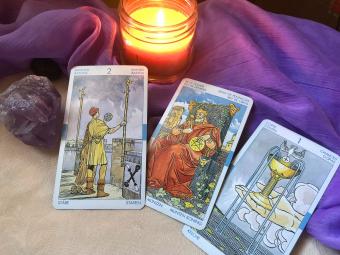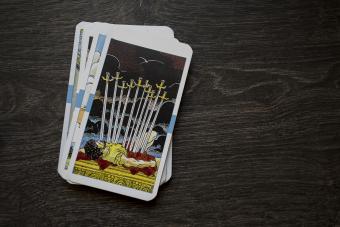
When I first started with tarot, instead of learning the meaning behind every specific card, I learned what the various tarot symbols meant. This made readings a lot easier.
Don't worry. We'll make it all make sense. Once you understand the tarot card symbols, you'll be able to toss away that book of tarot card meanings and read more intuitively.
The tarot symbolism in this article comes from the traditional Rider-Waite deck. You'll find different types of decks that all loosely follow the arrangement. If it doesn't have major arcana/minor arcana, it's probably an oracle deck instead of a tarot deck, and you'll need the booklet to interpret until you learn it a little better.
Tarot Symbols in the Minor Arcana
We'll start with the minor arcana, which are 56 cards in the deck that are kind of like suits in a regular deck of playing cards.
- Each minor arcana suit has 10 number cards (1-10) and four court cards (page, knight, queen, king).
- Minor arcana cards reflect things that are happening in day-to-day life.
- The four suits in a tarot deck are pentacles, cups, wands, and swords.
- Each minor arcana suit represents one of the four classical elements.
| Suit | Element | Meaning | How to Remember |
|---|---|---|---|
| Pentacles | Earth | Physical body/material world | The earth is round & so is a pentacle. |
| Cups | Water | Emotional realm | Cups hold liquid. |
| Wands | Fire | Spirituality/passion/drive | Wands shoot fire. |
| Swords | Air | Mental realm | Swords swish through the air. |
Pentacles Symbolism

In tarot, pentacles (sometimes called coins) represent the Earth element. This is a grounded element, and it's rooted in the physical. So when a pentacles card appears in a tarot spread, it offers info about something physical, which can include health or things in the physical world. Topics pentacle cards may cover include:
- Finances
- Health
- Property
- Business or trade
- Career
Cups Symbolism

Cups represent the water element, which is primarily about emotions. When cups appear in your tarot spread, it addresses issues associated with emotions. Some topics a cups card may represent include the following.
- Feelings and emotions
- Love and relationships
- Connections with others
- Personal interactions
- Creative endeavors
Wands Symbolism

Wands represent the fire element, an active and primal energy that's associated with spirituality, higher thought, passion, and drive. When wands show up in a reading, they may be indicating some of the following.
- Ambitions and goals
- Purpose
- Motivation and meaning
- Passion and drives
- Change
Swords Symbolism

Swords represent the air element, which is associated with your mental self and the realm of thought. Some things swords may represent when they show up in a tarot reading include the following.
- Challenges
- Confrontation
- Courage
- Conflicts and arguments
- Decisions
Tarot Symbolism for Numbers
Like a regular deck of cards, each minor arcana tarot card is either a number card (ace through 10) or a court card (Page, Knight, Queen, King). Each of these has its own symbolic meaning.
| Number | Symbolism |
|---|---|
| 1 (ace) | New beginnings, unity |
| 2 | Relationships, duality, balance, partnership |
| 3 | Creativity |
| 4 | Stability, structure |
| 5 | Luck, conflict, growth, change |
| 6 | Harmony |
| 7 | Life lessons, growing spiritually |
| 8 | Understanding and accomplishment |
| 9 | Success, coming to the end of a cycle |
| 10 | Completion, enlightenment |
Tarot Symbolism for Court Cards

The court cards are the face cards in each suit of the tarot. There are four in each suit, and they symbolize the following.
| Card | Symbolism |
|---|---|
| Page | Youthful energy, service |
| Knight | Taking action, mature energy, moving forward |
| Queen | Empathy, compassion |
| King | Leadership, attainment, success |
Color Symbolism on Tarot Cards

Tarot cards are colorful, and the colors chosen in the images tend to have symbolic meanings based on the psychological effects of colors and their association with chakras or auras. So when interpreting a tarot card, pay attention to the colors the artist or printer has chosen along with the images and numerology.
| Color | Symbolism |
|---|---|
| Black | Protection, groundedness, darkness or missing elements, illness, negativity, root chakra |
| Red | Groundedness, safety, security, passion, anger, root chakra |
| Pink | Love, femininity, compassion, forgiveness, heart chakra |
| Orange | Joy, creative ideas, optimism, sacral chakra |
| Brown | Stability, neutrality, comfort, earthiness, muddiness or lack of boundaries, sacral chakra |
| Yellow | Opportunity, spontaneity, enthusiasm, solar plexus chakra |
| Gold | Mastery, divinity, spiritual leadership, crown chakra or above |
| Green | Healing, love, harmony, balance, envy, bitterness, heart chakra |
| Blue | Communication, peace, self-expression, trust, sadness, judgment and criticism, throat chakra |
| Purple | Intuition, psychic ability, spirituality, reason, critical thinking, third eye chakra |
| White | Connection to the Divine, higher self, newness, innocence, inexperience, birth, crown chakra |
| Silver | Emotion, sensitivity, empathy, crown chakra |
Tarot Art & Images Symbolism

Most tarot decks have detailed artwork on each card. The elements within the scene can help you interpret the insights gathered during the reading. Many of these elements are not what they appear to be, but they are symbolic and may have a meaning that varies slightly from the obvious picture.
| Image | Symbolism |
|---|---|
| Angels |
|
| Blindfold |
|
| Cat |
|
| Dog |
|
| Flag |
|
| Grapes |
|
| Hammer |
|
| Ice |
|
| Keys |
|
| Lizard |
|
| Moon |
|
| Ocean |
|
| Pillar |
|
| Rain |
|
| Ship |
|
| Tree |
|
| Wreath |
|
Major Arcana Tarot Symbolism

The major arcana cards represent significant life events. There are 22 major arcana cards in the traditional tarot. Each of the major arcana cards has symbolism based on numerology and archetypes. The major arcana cards are numbered from 0 to XXI (21) and depict the soul's journey from newness and innocence to enlightenment.
| Number | Card | Symbolism |
|---|---|---|
| 0 | The Fool | Innocence, the beginning of a journey |
| I | The Magician | Creation, alchemy |
| II | The High Priestess | Subconscious, intuition |
| III | The Empress | Feminity, compassion, wise woman archetype |
| IV | The Emperor | Power, authority |
| V | The Hierophant | Spiritual guidance |
| VI | The Lovers | Relationships, partnerships |
| VII | The Chariot | Goals, ambitions, and motivation |
| VIII | Strength | Courage, perseverance, and standing up to life's challenges |
| IX | The Hermit | Going within to find wisdom |
| X | Wheel of Fortune | Impermanence, change |
| XI | Justice | Fairness, balance |
| XII | The Hanged Man | Patience, perspective |
| XIII | Death | Change, new beginnings, endings |
| XIV | Temperance | Moderation |
| XV | The Devil | Temptation, control or lack thereof |
| XVI | The Tower | Cataclysmic change |
| XVII | The Star | Healing, hope, encouragement |
| XVIII | The Moon | Subconsciousness, deep fears or emotions, reflection |
| XIX | The Sun | Happiness, joy, excitement, awakening |
| XX | Judgment | Recognizing how your past actions affect others, taking stock, righting past misdeeds |
| XXI | The World | Fulfillment, the end of a cycle or quest |
More About Interpreting Symbols on Tarot Cards
I've used universal symbolism in the interpretations above. What's that mean, you ask? Essentially, it means these are symbols that are agreed upon universally because they've grown to represent these things over years and generations. These are also known as collective symbols that mean the same thing outside of religion, culture, gender, race, family background, etc. For example, in collective symbolism, pregnancy and birth are widely recognized as representing creativity, and hearts represent love.
In some cases, though, the symbols may relate to personal symbolism, family symbolism, cultural symbolism, etc. In these cases, I always recommend going with your first thought when you see the card. Interpreting tarot is a highly intuitive process, and all the symbolism is just there to help you focus on your intuition.
Related: Tarot for Beginners: Reading Cards & Interpreting Meaning
Symbols Based on Personal Experiences and Beliefs
These tend to be personal and individualized. For example, if you had a pet cat when you were a child, a cat may symbolize joy, love, or happiness to you. I'm afraid of snakes, so in my personal mythology, snakes represent fear or danger.
Symbols Associated With Family or Community of Origin
Families and communities have their own symbols within the unit that vary from unit to unit. For example, plaid may represent family to a Scottish clan, while to someone else it may represent a school uniform.
Local and Regional Symbols
Where you live also affects how you view certain symbols. For example, if a local high school has a dolphin as a mascot, the dolphin may represent learning or sports prowess regionally.
Symbols Based on Religion, Racial Identity, Culture, Nation, or Heritage
Each of these societal units has its own symbolism that's important and recognizable to that group. For example, in the US, the eagle symbolizes freedom, and in the Christian religion, the cross represents the crucifixion.
Tarot Card Symbols Are a Great Place to Start
All of the above go into interpreting tarot cards based on their symbolism. I know it's a lot to remember, but this page makes a great cheat sheet as you get used to the symbols. The more tarot readings you do, the sooner it will be second nature.







